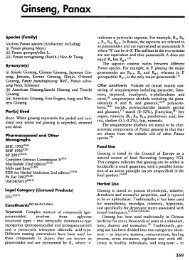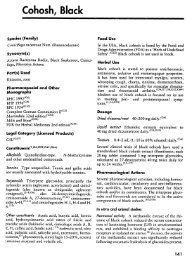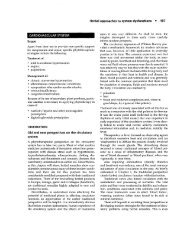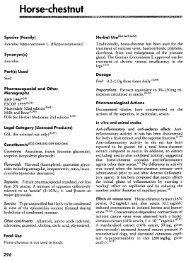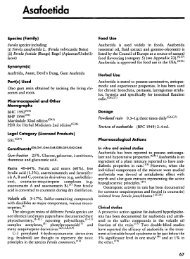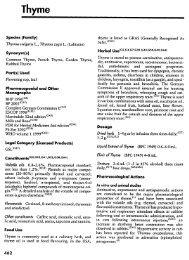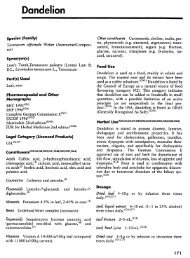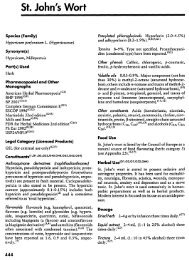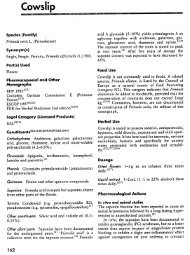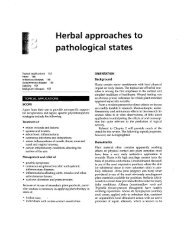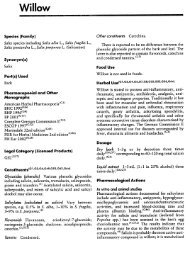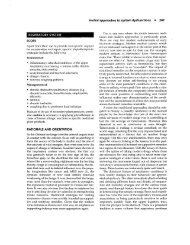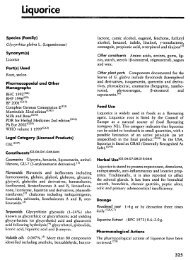Rhubarb
Rhubarb
Rhubarb
Create successful ePaper yourself
Turn your PDF publications into a flip-book with our unique Google optimized e-Paper software.
<strong>Rhubarb</strong><br />
401<br />
Species (Family)<br />
Rheum officinale<br />
Synonym(s)<br />
Baill . and R. palmatum . (Poly-<br />
Chinese <strong>Rhubarb</strong>, other Rheum species, e .g. Rheum<br />
tanguticum Maxim . & Reg., Rheum emodi Wall .<br />
(ndian <strong>Rhubarb</strong>) and Rheum rhaponticum .<br />
(arden <strong>Rhubarb</strong>)<br />
Part(s) Used<br />
Rhizome, root<br />
Pharmacopoeial and Other<br />
Monographs<br />
BC 1992 (6)<br />
BP 1996 (9)<br />
BP 2001 (15)<br />
Complete erman Commission E (3)<br />
ESCOP 1999 (52)<br />
Martindale 32nd edition (43)<br />
PDR for erbal Medicines 2nd edition (36)<br />
Ph Eur 2002 (21)<br />
WO volume 1 1999 (63)<br />
egal Category (icensed Products)<br />
S (37)<br />
(2,6,22,4 1,48,59,64)<br />
Constituents<br />
ydroxyanthrocenes Primarily anthraquinone 0-<br />
glycosides (anthraglycosides) of aloe-emodin, emodin,<br />
chrysophanol and physcion ; dianthrone glycosides<br />
of rhein (sennosides A and B) and their oxalates ;<br />
heterodianthrones including palmidin A (aloe-emodin,<br />
emodin), palmidin B (aloe-emodin, chrysophanol),<br />
palmidin C (chrysophanol, emodin), sennidin C<br />
(rhein, aloe-emodin), rheidin B (rhein, chrysophanol),<br />
and reidin C (rhein, physcion) ; free anthraquinones<br />
mainly aloe-emodin, chrysophanol, emodin,<br />
physcion and rhein .<br />
Tannins ydrolysable and condensed including<br />
glucogallin, free gallic acid, (-)-epicatechin gallate<br />
and catechin .<br />
Other constituents Calcium oxalate, fatty acids,<br />
rutin, resins, starch (about 16%), stilbene glycosides,<br />
carbohydrates, volatile oil (trace) with more<br />
than 100 components .<br />
Food Use<br />
<strong>Rhubarb</strong> is listed by the Council of Europe as a<br />
natural source of food flavouring (category N2) .<br />
This category indicates that it can be added to foodstuffs<br />
in small quantities, with a possible limitation of<br />
an active principle (as yet unspecified) in the final<br />
product . (16) <strong>Rhubarb</strong> stems are commonly eaten as<br />
a food. n the USA, rhubarb is permitted for food<br />
use . (65)<br />
erbal Use<br />
<strong>Rhubarb</strong> has been used traditionally both as a laxative<br />
and an antidiarrhoeal agent . (2,6,8,64)<br />
Dosage<br />
Rhizome/root 0 .2-1 .0 g.<br />
Pharmacological Actions<br />
The laxative action of anthraquinone derivatives is<br />
well recognised (see Senna) . <strong>Rhubarb</strong> also contains<br />
tannins, which exert an astringent action . At low<br />
doses, rhubarb is stated to act as an antidiarrhoeal<br />
because of the tannin components, whereas at higher<br />
doses it exerts a cathartic action .<br />
(42)<br />
Side-effects, Toxicity<br />
See Senna for side-effects and toxicity associated with<br />
anthraquinone-containing drugs . <strong>Rhubarb</strong> leaves are<br />
toxic because of the oxalic acid content and should<br />
not be ingested . A case of anaphylaxis following<br />
( 1)<br />
rhubarb ingestion has been documented .<br />
Contra-indications, Warnings (20)<br />
See Senna for contra-indications and warnings associated<br />
with anthraquinone-containing drugs . The<br />
astringent effect of rhubarb may exacerbate, rather<br />
than relieve, symptoms of constipation . )) t has been<br />
stated that rhubarb should be avoided by individuals<br />
suffering from arthritis, kidney disease or urinary<br />
problems . 47j
402 <strong>Rhubarb</strong><br />
Pregnancy and lactation It is stated that rhubarb<br />
should be avoided during pregnancy . IG42 ~ See Senna<br />
for contra-indications and warnings regarding the use<br />
of stimulant laxatives during pregnancy and lactation<br />
.<br />
The chemistry of rhubarb is characterised by the<br />
anthraquinone derivatives . The laxative action of<br />
these compounds is well recognised and justifies the<br />
use of rhubarb as a laxative . As with all anthraquinone-containing<br />
preparations, the use of non-standardised<br />
products should be avoided because their<br />
pharmacological effect will be variable and unpredictable<br />
.<br />
References<br />
Pharmaceutical Comment<br />
See also General References G2, G3, G6, G9, G12,<br />
G15, G16, G20, G22, G25, G29, G31, G36, G37,<br />
G41, G42, G43, G48, G51, G52, G56, G63 and G64 .<br />
1 Rohrback JA. Some uses of rhubarb in veterinary<br />
medicine . Herbalist 1983 ; 1 : 239-241 .



